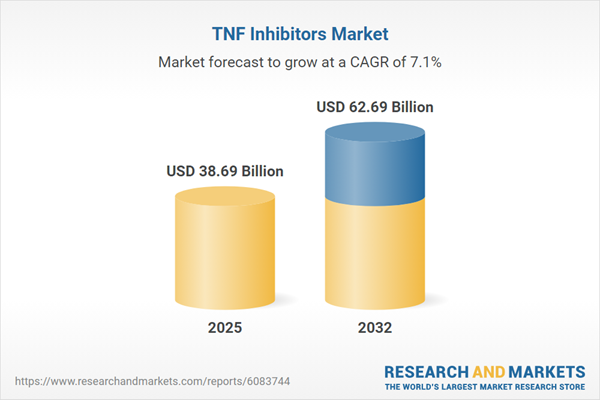Speak directly to the analyst to clarify any post sales queries you may have.
The TNF Inhibitors Market is undergoing rapid transformation as ongoing innovation, policy changes, and evolving care models redefine its role in chronic autoimmune disease management. Senior leaders require targeted insights into the drivers propelling demand, competitive actions, and strategic imperatives for success in this dynamic field.
Market Snapshot: TNF Inhibitors Market Growth and Landscape
The TNF inhibitors market grew from USD 36.15 billion in 2024 to USD 38.69 billion in 2025. It is forecast to sustain momentum, reaching USD 62.69 billion by 2032 at a CAGR of 7.12%. This positive growth trajectory is supported by expanding patient pools, new biosimilar introductions, and a globally rising prevalence of chronic autoimmune disorders. Therapeutic innovation and enhanced reimbursement are also strengthening market development across established and emerging economies.
Scope & Segmentation
- Indications: Ankylosing spondylitis, Crohn disease, plaque psoriasis, psoriatic arthritis, rheumatoid arthritis, ulcerative colitis
- Drug Types: Biosimilars – adalimumab, etanercept, infliximab; Originators – adalimumab, certolizumab pegol, etanercept, golimumab, infliximab
- Distribution Channels: Hospital pharmacy, online pharmacy (direct to patient, third party platforms), retail pharmacy (chain, independent)
- Route of Administration: Intravenous infusion, subcutaneous injection
- End Users: Clinics, home care settings, hospitals
- Regions: Americas (North America, Latin America), Europe, Middle East & Africa, Asia-Pacific, with comprehensive country coverage across major economies
- Industry Players: Coverage includes leading companies such as AbbVie, Janssen Biotech, Amgen, UCB, Pfizer, Celltrion Healthcare, Sandoz, Samsung Bioepis, Merck & Co., and Viatris
Key Takeaways for Senior Decision-Makers
- Scientific advancements have elevated antibody engineering and biosimilar development, driving improved safety and access for chronic autoimmune therapy recipients.
- Digital health platforms are supporting patient monitoring, adherence, and care optimization across clinical and home-based settings.
- Regulatory frameworks are evolving to balance biosimilar entry with ongoing safety and efficacy standards, streamlining approval and market access processes.
- Emerging market strategies leverage direct-to-patient models and robust life-cycle management to maintain competitiveness across diverse geographies.
- Diversification of supply chain and localized manufacturing are becoming pivotal in response to shifting trade environments and fluctuating procurement costs.
- Stakeholder collaboration—including with payers, advocacy groups, and regulators—remains central to reimbursement, patient support, and adoption of innovative therapies.
Tariff Impact: Navigating Policy Shifts in TNF Inhibitor Supply Chains
Newly imposed United States trade tariffs on critical pharmaceutical ingredients and specialized production materials have elevated supply chain costs for both original and biosimilar TNF inhibitor manufacturers. Companies are proactively adapting by exploring nearshoring, strengthening relationships with domestic suppliers, and expanding dual-sourcing models to safeguard continuity of supply. Diversified logistics and resilient inventory strategies are minimizing downstream disruptions for patients. This changing environment underlines the importance of adaptive planning and capacity investment for all stakeholders.
Methodology & Data Sources
This analysis leverages a rigorous, multi-stage research framework comprising interviews with senior executives and medical experts, as well as advisory panels from rheumatology and gastroenterology specialties. Secondary sources span regulatory filings, peer-reviewed journals, clinical trial registries, and public disclosures. Data triangulation and thematic analysis ensure consistency and dependability of insights, validated through independent review by external subject matter experts.
Why This Report Matters
- Provides decision-makers with validated, actionable intelligence for strategic market positioning and risk mitigation.
- Enables identification of emerging growth areas—including biosimilar competition, technology integration, and regional expansion opportunities.
- Supports planning with clear segmentation, supply chain impact assessment, and evolving policy analysis relevant to senior industry roles.
Conclusion
The TNF inhibitors market is shaped by scientific progress, shifting regulatory environments, and the diversification of access pathways. For organizations seeking to lead or expand, strategic agility and stakeholder alignment will be essential for sustained opportunity capture in the years ahead.
Table of Contents
3. Executive Summary
4. Market Overview
7. Cumulative Impact of Artificial Intelligence 2025
Companies Mentioned
The companies profiled in this TNF Inhibitors market report include:- AbbVie Inc.
- Janssen Biotech, Inc.
- Amgen Inc.
- UCB S.A.
- Pfizer Inc.
- Celltrion Healthcare Co., Ltd.
- Sandoz International GmbH
- Samsung Bioepis Co., Ltd.
- Merck & Co., Inc.
- Viatris Inc.
Table Information
| Report Attribute | Details |
|---|---|
| No. of Pages | 192 |
| Published | November 2025 |
| Forecast Period | 2025 - 2032 |
| Estimated Market Value ( USD | $ 38.69 Billion |
| Forecasted Market Value ( USD | $ 62.69 Billion |
| Compound Annual Growth Rate | 7.1% |
| Regions Covered | Global |
| No. of Companies Mentioned | 11 |









